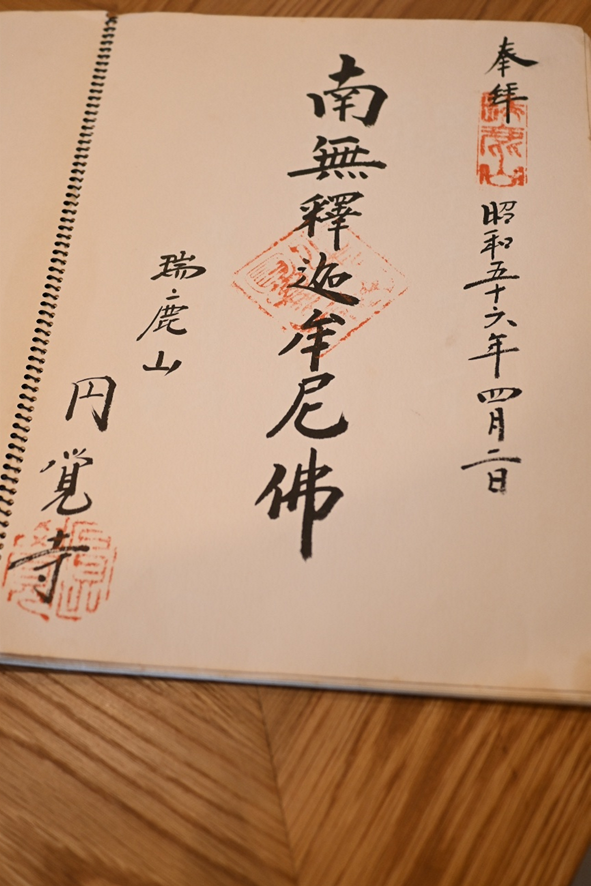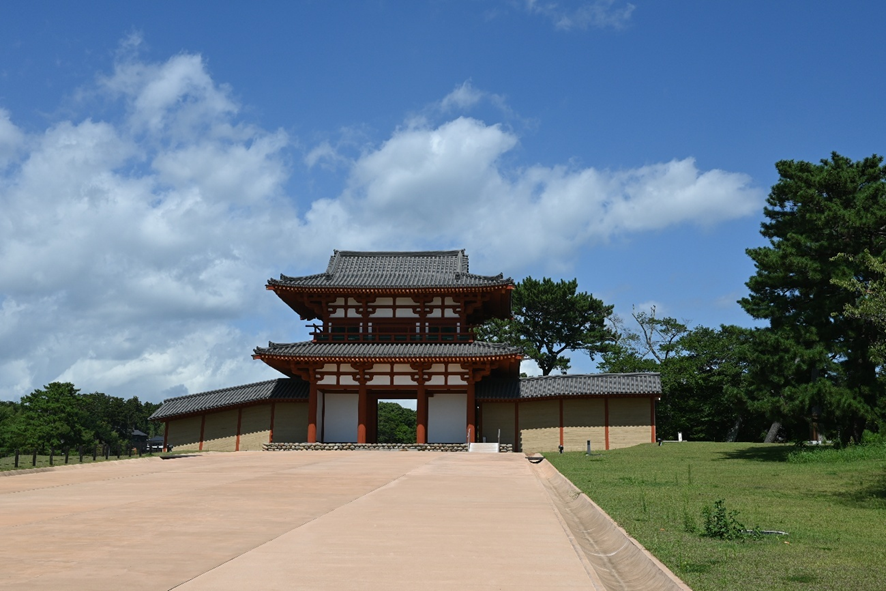Kita Kamakura Walk ~SEP,2025~
- 羽場 広樹

- Sep 27
- 7 min read

While living in Tokyo, one tends to think that Kamakura is close and one can go there anytime, but I decided to take a leisurely walk there for the first time in over 40 years. To be precise, I had passed through there ten years ago to get a temple seal while pilgrimage to the Bando Kannon temples, but I only drove around to a few temples and shrines on my precious day off as a working adult, so it was far from the experience of visiting historical sites in medieval Japan.

In the spring of my third year of high school, I begged my parents to let me come to Tokyo to take a cram school course. On a day when classes were not held, I visited Kamakura with a large sketchbook and had several goshuin stamps stamped on it. At the time, I didn't even know about goshuincho (stamp notebooks), and now I'm humbled to think that I had casually had them written on such a large thing.

Needless to say, Kamakura is where Minamoto no Yoritomo established his shogunate and is a sacred place for the Seiwa Genji clan, but it was originally land given to his adopted son, Minamoto no Yoriyoshi, by Taira no Naokata, the head of the Kanmu Heishi clan. Yoshiie, Yoshitsuna, and Yoshimitsu were the sons born during this "Genpei marriage," and the descendants of Yoshiie and Yoshimitsu in particular continued to play key roles in the 800 years of samurai politics that followed.

Kita-Kamakura is an area that corresponds to Yamanouchi in terms of address, and Koshoji Temple is located at the entrance. It is said that Ippen was trying to enter Kamakura to preach but was stopped by soldiers of Hojo Tokimune, and was forced to camp out here. This is where Kita-Kamakura begins.

Engakuji Temple, a large temple complex founded by Hojo Tokimune, who repelled the Mongol invasions, is located directly in front of Kita-Kamakura Station. Tokimune died shortly thereafter, and his mausoleum, Butsunichi-an, is located within the temple grounds. The Mongol invasions were the greatest national crisis in medieval Japan, but Japan managed to overcome them remarkably well. Prior to that, during the late Heian period and the subsequent Nanboku-cho period, they may have been difficult to unite the nation in defense. Tokimune, the eldest son of the Tokuso family and a leading figure, became regent at the age of 18. He died at the age of 32, but more than half of his reign was spent dealing with the Mongol invasions. His eldest son, Sadatoki, later assumed the position at the age of 12. However, the young regents, including his successor, Takatoki, naturally invited tyranny from his inner circle (the Tokuso family stewards), shortening the lifespan of the Kamakura shogunate. The day I visited coincidentally coincided with the anniversary of Sadatoki's death.

One of the reasons the Kamakura period was relatively short is the short lifespan of the Hojo clan. It's true that the fourth shogun, Tokiuji, through Sadatoki, died between the ages of 23 and 41 (the last, Takatoki, committed suicide at the age of 31), which makes one wonder if there was some genetic problem, but at least the Hojo clan continued to practice fairly intense incestuous marriages and marriages with some powerful vassals. Considering that successive Tokugawa shoguns, from Iemitsu onwards, were born to a variety of concubines who did not share the family's mother, it may have been a lesson to relax somewhat the obsession with blood purity that prevailed during the Kamakura and Muromachi periods.

In European royal lines, there are examples such as the House of Habsburg, which declined due to an excessive emphasis on blood purity, and the spread of hemophilia among European royal families through Queen Victoria, so closed marriages carry certain risks. Simply put, Japan has protected the bloodline of imperial and royal lines by allowing the children of concubines to become legitimate, while Europe has recognized matrilineal inheritance. According to dentist Dr. Hirashita, severe incest can lead to pointed lower jaws.

The Shariden Hall, a National Treasure, is open to the public at certain times of the year, but is usually only viewed from a distance. During the Sengoku period, Satomi Yoshihiro of Awa fell in love with a nun from Taiheiji (Seigaku-ni), attacked Kamakura, kidnapped her, and made her his wife. Taiheiji was abandoned, but the Shariden Hall that was located there was moved to Engakuji Temple. The ruins of Taiheiji Temple are located behind Tsurugaoka Hachimangu Shrine.

Engakuji Temple has another national treasure, a bell cast by Sadatoki. The hot sandwiches at the small cafe next door were delicious.

In Yamanouchi, the Yokosuka Line runs along the valley floor leading to Kamakura, and temples line the grounds. I decided to walk counterclockwise after leaving Engakuji Temple. On the right is Tokeiji Temple, famous as a temple for breaking off relationships. The temple has a delicate and beautiful garden and halls, typical of a nunnery, but photography is prohibited anywhere within the temple grounds.

Founded by Tokimune's wife, Kakuzan-ni, this temple has maintained its high status even after the fall of the Kamakura shogunate, welcoming Emperor Godaigo's daughter, Yodo-ni, and Toyotomi Hideyori's daughter, Tenshu-ni (adopted daughter of Senhime). The Toyotomi clan was defeated in the Summer Siege of Osaka, and Hideyori's son, Kunimatsu, was beheaded, but his sister, Tenshu-ni, was spared and became the chief priest of Tokei-ji Temple. Due to its connection with the Tokugawa family, there is much to see, but it is clear that the temple wishes to maintain a quiet environment as a place of prayer.

Jochiji Temple was founded by Tokimune's eldest son, Munemasa, who was the fourth of the Five Mountains of Kamakura, to commemorate the soul of his brother, Munemasa. Munemasa also served as regent as a pinch hitter when Sadatoki became a monk.

I couldn't find Shibusawa Tatsuhiko's grave, so I paid my respects to the Hotei and Jizo statues in the temple grounds before leaving. Shibusawa passed away at the age of 59 when I was a student, and I was surprised to find myself older than him.

I came to Chojuji Temple, but apparently it's only open on weekends during certain seasons, so I couldn't go inside. This was originally the site of Ashikaga Takauji's residence, and later his son Motouji became the Kamakura kubo and built a large temple. During the Kamakura period, most heads of the Ashikaga clan married members of the Hojo clan, so it's no exaggeration to say that in terms of lineage, Ashikaga = Hojo. Takauji had an older brother (Takayoshi) whose mother was from the Hojo clan, but he died young, and Takauji became the eldest son, even though his mother was from the Uesugi clan.

Takauji, who succeeded the Ashikaga clan, married Akahashi Noriko of the Hojo clan, and gave birth to the next Shogun, Yoshiakira, and the Kamakura Kubo Motouji, and appointed the Uesugi clan to the position of Kanto Kanrei. The Kamakura Hojo clan, including Takatoki, committed suicide at Toshoji Temple, but their bloodline continued as the Ashikaga clan. Even so, Yasuko Sawaguchi never ages.

At the end of the Yamanouchi valley, just before the tunnel that leads to Kamakura, there is Ennoji Temple. Ten Yama statues are enshrined here, and the principal image of the temple is said to have been created by Unkei and is designated as an Important Cultural Property. Being surrounded by Yama statues naturally makes you feel humble, and it gave me an opportunity for reflection for the first time in a long time.

Here, turn around and walk to the right side of the road, passing through the gates of Kenchoji Temple, founded by Tokiyori, the father of Tokimune.

The Buddhist temple hall is currently undergoing preservation and repair work and is therefore closed to the public, but the memory of looking up at the temple gate from over 40 years ago came back to me. What's different from back then is that my interest in viewing cultural properties has changed. In recent years, I've enjoyed admiring Buddhist statues, garden features, and temple bells, and here I was captivated by the National Treasure temple bell. The bell at Engakuji Temple mentioned above was donated by Sadatoki, and although it was cast just under 50 years earlier, it was cast by the same Mononobe family. Buddhist statues at temples east of Izu are by the Kei school, including Unkei, and temple bells cast by the Mononobe family can be found here and there from the Kamakura period onwards. The Mononobe family were apparently originally professional metalworkers based in Kawachi, but it shows that the focus of Buddhist art was shifting from west to east.

The neighboring Kamakura Gakuen is Keisuke Kuwata's alma mater.

On the way back to Kita-Kamakura Station, after passing the Yokosuka Line railroad crossing, there is a small stream running along the road. It is called Meigetsugawa River, and walking upstream along it leads to Meigetsuin Temple. This is the only path I remember from my visit over 40 years ago, and I recalled how I trudged along it.

This temple is famous for its hydrangeas, but it is beautiful even without them. There is a large garden in the back that is currently under construction, and the view of the Window of Enlightenment from behind is also quite picturesque. Originally, there was Zenkoji Temple, which was built on the site of Hojo Tokiyori's private residence, and Meigetsuin Temple was restored as a sub-temple by Kanto Kanrei Uesugi Norikata during the Muromachi period. Zenkoji Temple was abandoned after the Meiji Restoration, and Meigetsuin Temple now houses Tokiyori's mausoleum.

In one corner of the garden, which is currently under construction, there are several Jizo statues wearing different colored vests. Without exception, they all have peaceful expressions. Walk about 400 meters to return to Kita-Kamakura Station.





Comments